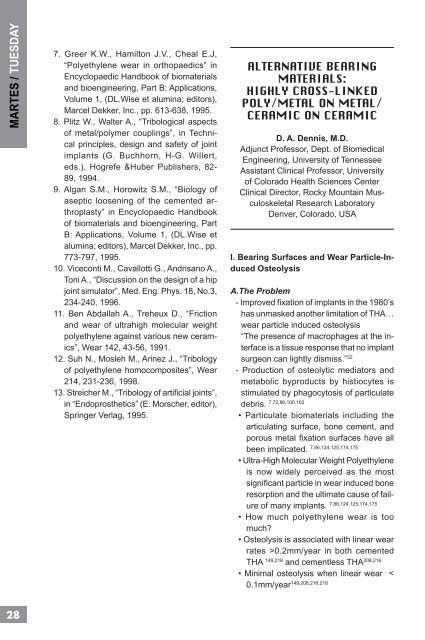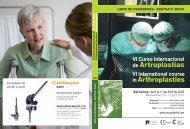cadera / hip - Active Congress.......
cadera / hip - Active Congress.......
cadera / hip - Active Congress.......
Create successful ePaper yourself
Turn your PDF publications into a flip-book with our unique Google optimized e-Paper software.
MARTES / TUESDAY<br />
28<br />
7. Greer K.W., Hamilton J.V., Cheal E.J,<br />
“Polyethylene wear in orthopaedics” in<br />
Encyclopaedic Handbook of biomaterials<br />
and bioengineering, Part B: Applications,<br />
Volume 1, (DL.Wise et alumina; editors),<br />
Marcel Dekker, Inc., pp. 613-638, 1995.<br />
8. Plitz W., Walter A., “Tribological aspects<br />
of metal/polymer couplings”, in Technical<br />
principles, design and safety of joint<br />
implants (G. Buchhorn, H-G. Willert,<br />
eds.), Hogrefe &Huber Publishers, 82-<br />
89, 1994.<br />
9. Algan S.M., Horowitz S.M., “Biology of<br />
aseptic loosening of the cemented arthroplasty”<br />
in Encyclopaedic Handbook<br />
of biomaterials and bioengineering, Part<br />
B: Applications, Volume 1, (DL.Wise et<br />
alumina; editors), Marcel Dekker, Inc., pp.<br />
773-797, 1995.<br />
10. Viceconti M., Cavallotti G., Andrisano A.,<br />
Toni A., “Discussion on the design of a <strong>hip</strong><br />
joint simulator”, Med. Eng. Phys. 18, No.3,<br />
234-240, 1996.<br />
11. Ben Abdallah A., Treheux D., “Friction<br />
and wear of ultrahigh molecular weight<br />
polyethylene against various new ceramics”,<br />
Wear 142, 43-56, 1991.<br />
12. Suh N., Mosleh M., Arinez J., “Tribology<br />
of polyethylene homocomposites”, Wear<br />
214, 231-236, 1998.<br />
13. Streicher M., “Tribology of artifi cial joints”,<br />
in “Endoprosthetics” (E. Morscher, editor),<br />
Springer Verlag, 1995.<br />
ALTERNATIVE BEARING<br />
MATERIALS:<br />
HIGHLY CROSS-LINKED<br />
POLY/METAL ON METAL/<br />
CERAMIC ON CERAMIC<br />
D. A. Dennis, M.D.<br />
Adjunct Professor, Dept. of Biomedical<br />
Engineering, University of Tennessee<br />
Assistant Clinical Professor, University<br />
of Colorado Health Sciences Center<br />
Clinical Director, Rocky Mountain Musculoskeletal<br />
Research Laboratory<br />
Denver, Colorado, USA<br />
I. Bearing Surfaces and Wear Particle-Induced<br />
Osteolysis<br />
A.The Problem<br />
- Improved fi xation of implants in the 1980’s<br />
has unmasked another limitation of THA…<br />
wear particle induced osteolysis<br />
“The presence of macrophages at the interface<br />
is a tissue response that no implant<br />
surgeon can lightly dismiss.” 32<br />
- Production of osteolytic mediators and<br />
metabolic byproducts by histiocytes is<br />
stimulated by phagocytosis of particulate<br />
debris. 7,72,86,100,102<br />
• Particulate biomaterials including the<br />
articulating surface, bone cement, and<br />
porous metal fi xation surfaces have all<br />
been implicated. 7,86,124,125,174,175<br />
• Ultra-High Molecular Weight Polyethylene<br />
is now widely perceived as the most<br />
signifi cant particle in wear induced bone<br />
resorption and the ultimate cause of failure<br />
of many implants. 7,86,124,125,174,175<br />
• How much polyethylene wear is too<br />
much?<br />
• Osteolysis is associated with linear wear<br />
rates >0.2mm/year in both cemented<br />
THA 149,218 and cementless THA 208,216<br />
• Minimal osteolysis when linear wear <<br />
0.1mm/year 149,208,216,218





